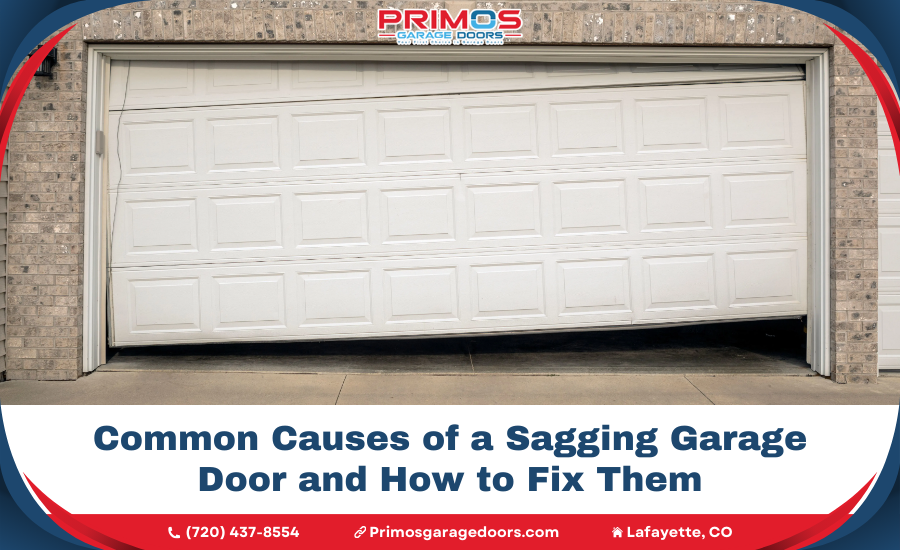Is your garage door uneven or sagging? A sagging garage door isn’t just an eyesore; it can also pose significant safety risks and lead to costly repairs if not addressed promptly. Understanding the causes and solutions for a sagging garage door can help you maintain a safe and functional home environment.
In this article, we’ll explore:
- Common Causes: Discover what typically causes garage doors to sag, from wear and tear to environmental factors.
- Balance Issues: Learn how to identify and correct balance problems that often lead to sagging.
- DIY Solutions: Get step-by-step instructions for fixing minor issues yourself.
- When to Seek Professional Help: Know when it’s time to call in the experts to avoid further damage.
Whether you’re a DIY enthusiast looking to tackle the problem on your own or a homeowner considering professional repair, this guide provides all the insights you need. Keep reading to find out how you can ensure your garage door operates smoothly and safely.
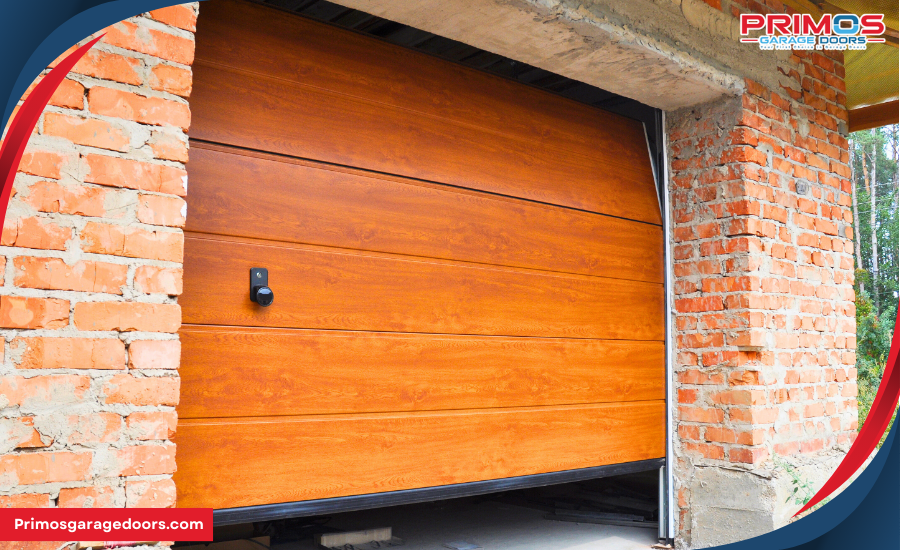
Spotting an Unbalanced Door
Signs of an Unbalanced Garage Door
A sagging garage door can show several signs indicating that it’s unbalanced. Recognizing these signs early can help you address the issue before it leads to more severe problems.
- Uneven Movement During Opening or Closing: One of the most noticeable signs of an unbalanced garage door is when it moves unevenly. If one side of the door rises or lowers faster than the other, it’s a clear indication of balance issues. This uneven movement can cause strain on the door’s components, leading to further damage.
- Garage Door Sags When Fully Open: Another sign is when the garage door sags in the middle when it’s fully open. This sagging indicates that the door is not properly supported, which could be due to worn-out springs or other components.
- Strange Sounds During Operation: If you hear unusual sounds like grinding, creaking, or squeaking when the door is in operation, it’s a sign that something is wrong. These noises often result from misaligned garage door tracks or parts that are not functioning correctly due to an imbalance.
Identifying these signs early can help prevent more significant issues and costly repairs. Regular maintenance and timely intervention are crucial in keeping your garage door in optimal condition.
Why Balance Matters
A balanced garage door is essential for several reasons. Understanding the importance of balance can help you appreciate the need for regular inspections and maintenance.
- Longevity of the Door: When a garage door is balanced, it operates smoothly, reducing the wear and tear on its components. Garage door springs, cables, and other parts last longer when they’re not under undue stress. This extends the life of your garage door, saving you money on repairs and replacements.
- Functionality and Performance: A balanced door ensures that your garage door opener works efficiently. If the door is unbalanced, the opener has to work harder, which can lead to faster wear and potential failure. Proper balance helps in maintaining the smooth operation of the door, ensuring that it opens and closes correctly every time.
- Safety Concerns: An unbalanced garage door can be a safety hazard. It can suddenly fall or close unexpectedly, posing a risk to people and pets. Ensuring your door is balanced can prevent accidents and injuries, making your home safer.
Keeping your garage door balanced is crucial for its performance, longevity, and safety. Regular checks and maintenance can help you avoid the complications that arise from an unbalanced door, ensuring it serves you well for years to come.
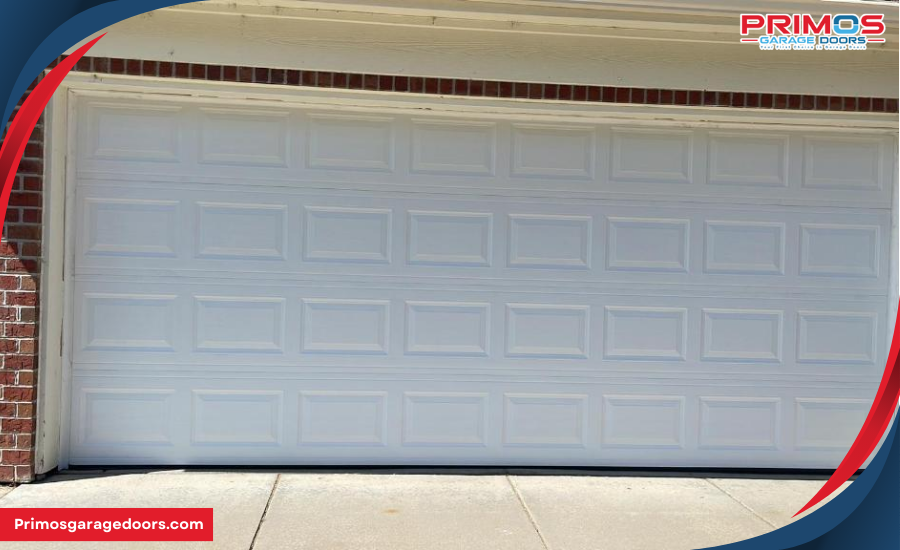
What Makes a Garage Door Balanced or Unbalanced
Components Affecting Balance
Several key components are crucial in keeping a garage door balanced. Understanding these parts helps in maintaining the door’s proper function and identifying issues before they escalate.
- Springs: Garage door springs are vital in balancing the door’s weight. There are two types: torsion springs and extension springs. Torsion springs are located above the closed door and use torque to lift the door. Extension springs are found on either side of the door and stretch to provide lifting force. If these springs weaken or break, the door can become unbalanced.
- Cables: Garage door cables work in tandem with the springs. They run from the bottom of the door to the spring system, supporting the door’s weight during movement. Damaged or frayed cables can lead to uneven door operation and balance issues.
- Hinges: Hinges connect the various sections of the garage door. They allow the door to bend and move along the tracks smoothly. Worn-out or broken hinges can disrupt the door’s alignment, causing it to become unbalanced.
- Tracks: The garage door tracks guide the door’s movement. If the tracks are bent or misaligned, the door may not move evenly, leading to balance problems. Regularly checking and adjusting the tracks is crucial for maintaining balance.
Factors Leading to Imbalance
Several factors can cause a garage door to become unbalanced. Recognizing these factors can help in preventing balance issues and maintaining the door’s functionality.
- Wear and Tear: Garage doors are used frequently, which leads to natural wear and tear over time. Components like springs, cables, and hinges degrade with use, affecting the door’s balance. Regular maintenance can help identify and replace worn parts before they cause significant issues.
- Poor Installation: If a garage door is not installed correctly, it can be prone to balance problems from the start. Improper alignment of the tracks, incorrect spring tension, or loosely fitted hinges can all lead to an unbalanced door. Ensuring professional installation can prevent these issues.
- Environmental Factors: Extreme weather conditions can also impact the balance of a garage door. Harsh weather conditions like high humidity, fluctuating temperatures, and exposure to elements can cause components to expand, contract, or rust. This can lead to misalignment and wear, resulting in an unbalanced door.
- Lack of Maintenance: Regular maintenance is essential for keeping a garage door balanced. Neglecting maintenance tasks like lubrication, tightening hardware, and inspecting parts can cause small issues to develop into significant problems. Maintaining a consistent maintenance schedule helps in early detection and resolution of potential balance issues.
By understanding the components that affect the balance of a garage door and the factors that can lead to imbalance, homeowners can take proactive steps to ensure their garage door operates smoothly and safely. Regular inspections, proper installation, and timely maintenance are key to preventing and addressing balance issues.
Negative Consequences of an Unbalanced Door
Safety Hazards
An unbalanced garage door poses significant safety risks. The most immediate concern is the potential for the door to fall unexpectedly. When the balance is off, the garage door might not stay in place when open, posing a danger to anyone nearby. This is particularly hazardous if there are children or pets around who might not be aware of the risk. An unstable door can also close too quickly, potentially injuring anyone caught under it.
In addition, the uneven movement caused by balance issues can lead to misaligned garage door tracks. This misalignment increases the chance of the door coming off its tracks, which can be dangerous and cause severe injuries. Regularly checking and maintaining the balance of your garage door is crucial to avoid these safety hazards and ensure the door operates safely.
Damage to Garage Door Components
An unbalanced garage door can lead to significant wear and tear on its components. When the door is not balanced, parts such as springs, cables, and hinges experience uneven stress. For example, if the garage door springs are not balanced, one side might carry more weight than the other. This imbalance can cause the springs to wear out faster, leading to breakage.
Similarly, garage door cables can fray or snap under uneven tension, and hinges may bend or break due to misalignment. The garage door opener also suffers from this imbalance. An unbalanced door makes the opener work harder, leading to faster wear on its motor and gears. Regularly inspecting and adjusting the balance can prevent these issues and prolong the life of your garage door components.
Increased Repair Costs
Ignoring an unbalanced garage door can lead to more expensive repairs over time. The additional stress on components not only causes them to wear out faster but can also result in significant damage that requires professional intervention. For instance, if garage door tracks are bent or misaligned due to an imbalance, it might necessitate a complete track replacement, which can be costly.
Moreover, when parts like springs or cables break, they can cause collateral damage to other components, increasing repair costs. Regular maintenance and timely adjustments to keep the door balanced can save homeowners a considerable amount of money by preventing these extensive repairs.
Maintaining a balanced garage door is essential for safety, longevity, and cost-effectiveness. By regularly checking the balance and addressing issues promptly, you can avoid the dangerous and costly consequences of an unbalanced door. Regular inspections, proper adjustments, and timely replacements of worn parts are key practices to ensure your garage door remains safe and functional.
How to Perform a Balance Test
Preparing for the Test
Before performing a balance test on your garage door, it’s crucial to take some safety precautions and gather the necessary tools. Ensuring safety will prevent injuries and protect your garage door from potential damage.
- Safety Precautions: First, make sure the area around the garage door is clear of any obstacles. This includes vehicles, tools, and other objects that might obstruct the door’s movement. Wear safety gloves and eye protection to shield yourself from any potential hazards. Inform everyone in the household that you’re performing maintenance on the door, so they stay clear of the area.
- Tools Needed: You’ll need a few basic tools to perform the balance test. These include a step ladder, a wrench set, and a pair of locking pliers. If your garage door uses extension springs, have a piece of tape or a marker ready for marking positions. For torsion springs, ensure you have a safe way to lock the door in place.
Step-by-Step Guide
Performing a balance test involves checking if your garage door stays in place when manually lifted to the halfway point. Follow these detailed steps to ensure accurate results:
- Disconnect the Opener: Start by disconnecting the garage door opener. This can usually be done by pulling the emergency release cord, which allows you to operate the door manually.
- Lift the Door Manually: Stand inside the garage and lift the door manually. Carefully raise the door to the halfway point and let go. The door should stay in place without moving up or down.
- Observe the Movement: If the door moves up or down, it indicates a balance issue. A door that falls indicates that the garage door springs are too loose, while a door that rises suggests that the springs are too tight.
- Check for Smooth Operation: While manually operating the door, ensure it moves smoothly without any jerking or resistance. Misaligned garage door tracks can cause imbalance, so observe the tracks for any irregularities.
- Mark the Position: For extension spring doors, mark the current position of the springs before making any adjustments. This helps in returning the springs to their original position if needed.
- Adjust the Springs: If the door doesn’t stay in place, adjust the garage door springs accordingly. Tighten or loosen the springs gradually, testing the door’s balance after each adjustment. Use locking pliers to secure the springs during adjustments to prevent sudden movements.
- Reconnect the Opener: Once the door is balanced, reconnect the garage door opener. Test the door’s operation with the opener to ensure it’s functioning correctly.
Interpreting the Results
After performing the balance test, understanding the results is crucial for determining the next steps:
- Door Stays in Place: If the door stays in place when lifted to the halfway point, it indicates that the garage door is properly balanced. No further adjustments are needed, but regular maintenance checks are recommended.
- Door Falls: If the door falls, the garage door springs are too loose. This can cause strain on the opener and other components, leading to further damage. Tighten the springs gradually until the door stays in place during the test.
- Door Rises: If the door rises, the springs are too tight. Overly tight springs can cause the door to jerk and move unevenly, posing a safety risk. Loosen the springs gradually until the door maintains its position.
- Smooth Operation: Ensure the door moves smoothly without any resistance or jerking. If the door operates roughly, check the garage door tracks for alignment issues and adjust them as needed.
Performing a balance test on your garage door is a vital maintenance task that ensures safety and prolongs the life of your door. Regular checks and adjustments can prevent costly repairs and maintain the smooth operation of your garage door. If you encounter persistent issues or are unsure about the adjustments, seek professional help to ensure your door is safely and correctly balanced.
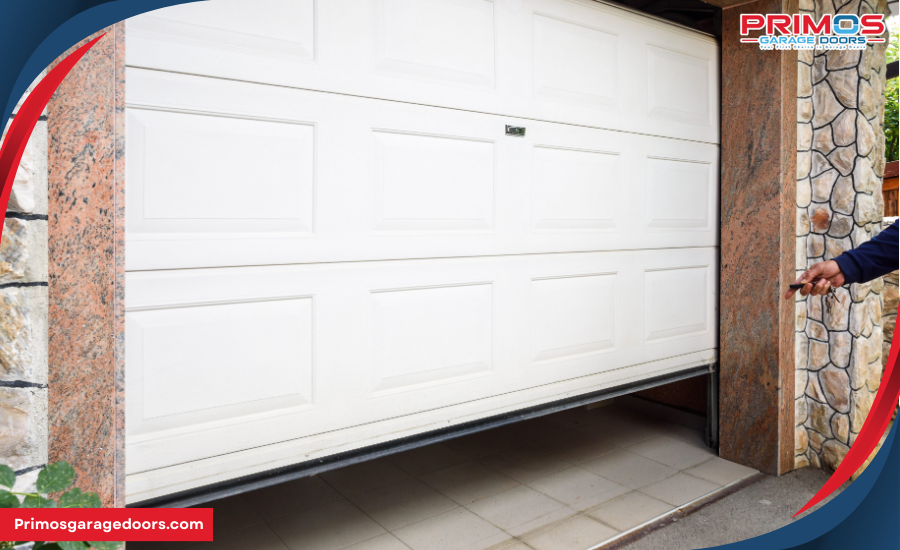
Dealing with an Unbalanced Door
Tightening Hardware
To ensure your garage door operates smoothly, it’s essential to check and tighten all hardware components regularly. Loose hardware can cause the door to become unbalanced and may lead to further damage.
- Check Bolts and Screws: Start by inspecting all bolts and screws along the door and its garage door tracks. Use a wrench or screwdriver to tighten any that have come loose. Pay particular attention to the brackets that hold the tracks to the wall and ceiling. Loose brackets can cause the tracks to misalign, leading to an uneven garage door.
- Secure Hinges: Examine the hinges that connect the sections of the garage door. These hinges can wear out over time, especially if they are not regularly lubricated. Tighten any loose hinge screws and replace any damaged hinges to ensure the door sections move smoothly.
- Inspect Rollers: The rollers play a critical role in guiding the garage door along the tracks. Ensure that all roller brackets are securely fastened. If the rollers are worn or damaged, consider replacing them with new ones to prevent further imbalance and to ensure a smoother operation.
Lubrication Tips
Proper lubrication is key to maintaining a well-functioning garage door. It reduces friction and wear on moving parts, helping to prevent sagging and other balance issues.
- Choose the Right Lubricant: Use a high-quality lithium-based or silicone-based lubricant. Avoid using WD-40 as it is not a proper lubricant for garage doors. It can actually remove the necessary grease from moving parts.
- Lubricate the Springs: Apply a generous amount of lubricant to the garage door springs. This helps reduce the tension and wear on the springs, ensuring they work effectively to balance the door. For torsion springs, spray the lubricant along the top of the spring and allow it to seep into the coils.
- Lubricate Hinges and Rollers: Spray lubricant on the hinges, ensuring that it penetrates the moving parts. Also, lubricate the rollers, especially if they are made of metal. Plastic rollers with no bearings do not need lubrication, but metal rollers do.
- Track Maintenance: Although you do not need to lubricate the tracks themselves, keeping them clean is essential. Wipe down the garage door tracks to remove any dirt or debris that could cause the door to become unbalanced. A clean track ensures smooth operation and reduces the likelihood of misalignment.
Adjusting Springs
Adjusting the garage door springs is a delicate task that requires caution. Springs are under high tension and can be dangerous if not handled properly. Here’s a guide to adjusting them safely:
- Identify the Type of Springs: Determine whether your garage door uses torsion springs or extension springs. Torsion springs are mounted above the door, while extension springs are found on either side of the door.
- Torsion Spring Adjustment:
- Tools Needed: You will need winding bars, a wrench, and safety glasses.
- Steps: First, unplug the garage door opener to prevent accidental activation. Use the winding bars to carefully release the tension on the springs by turning them counterclockwise. Adjust the spring tension by turning the winding bars in the opposite direction. Add or remove tension in small increments, checking the door’s balance after each adjustment.
- Extension Spring Adjustment:
- Tools Needed: You will need a ladder, a wrench, and safety glasses.
- Steps: Secure the door in the open position by clamping the garage door tracks with locking pliers. Disconnect the extension springs from their brackets and adjust their tension by moving the hook to a different hole. This will either increase or decrease the tension, depending on the direction of the adjustment. Reattach the springs and test the door’s balance.
Regularly inspecting and maintaining the garage door springs, hardware, and moving parts can prevent balance issues and prolong the life of your garage door. If you’re unsure about making these adjustments yourself, it’s best to consult a professional to avoid injury and ensure the job is done correctly.
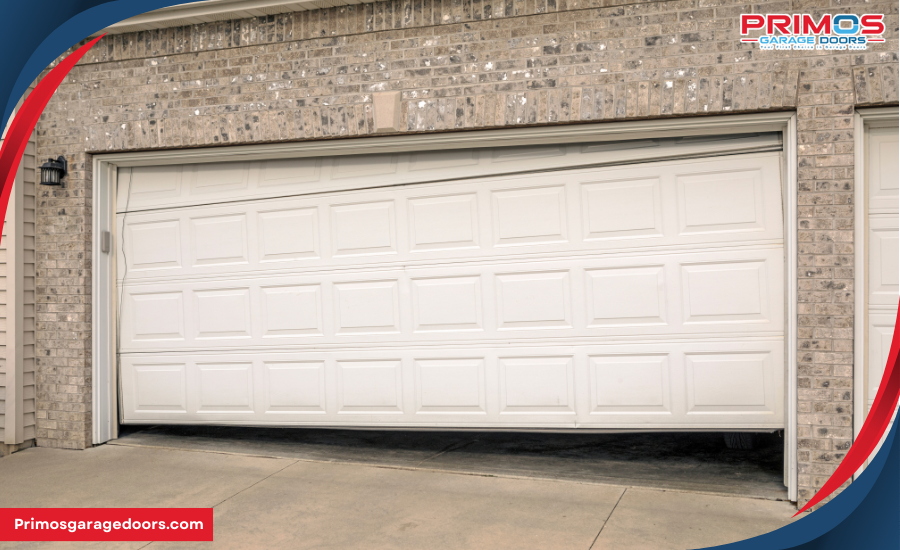
Dealing with a Sagging Door
Identifying Sagging Issues
A sagging garage door can exhibit several specific symptoms that indicate it’s time to address the problem. Recognizing these symptoms early can prevent further damage and ensure the door operates smoothly.
- Visible Gap in the Middle: One of the most obvious signs of a sagging garage door is a noticeable gap when the door is closed. This gap usually appears in the middle, indicating that the door is not aligned properly.
- Uneven Movement: If your garage door moves unevenly when opening or closing, it’s likely sagging. The door might struggle to move smoothly, often jerking or catching on one side.
- Difficulty Opening or Closing: A sagging door can make it difficult to open or close the garage door. This is because the misalignment puts extra strain on the garage door opener and other components.
- Noises During Operation: Listen for unusual sounds like creaking, popping, or scraping when the door is in motion. These noises often indicate that the door is straining due to sagging.
Immediate Fixes
While permanent solutions are ideal, immediate fixes can help minimize damage and maintain functionality.
- Tighten Loose Hardware: Start by tightening all screws, bolts, and hinges. This can help improve the alignment and reduce further sagging. Check the garage door tracks and ensure they are securely fastened to the wall and ceiling.
- Lubricate Moving Parts: Apply lubricant to the springs, hinges, and rollers. Proper lubrication reduces friction and allows the door to move more freely, even if it’s sagging. Use a high-quality silicone-based or lithium-based lubricant for the best results.
- Adjust the Tracks: If the garage door tracks are misaligned, gently tap them back into place with a rubber mallet. Ensure the tracks are parallel to each other and correctly aligned with the door.
- Use Temporary Supports: Place a temporary support or brace in the middle of the door to reduce the gap and provide extra stability. This is a short-term solution that can help until more permanent repairs are made.
Long-term Solutions
For a permanent fix, you’ll need to address the root causes of the sagging. This often involves replacing worn parts and ensuring the door is properly balanced.
- Replace Worn Springs: Garage door springs are crucial for maintaining balance. If they are worn or damaged, they should be replaced. For torsion springs, this is a job best left to professionals due to the high tension involved. If you have extension springs, you can replace them by following the manufacturer’s instructions.
- Install a Strut: Adding a garage door strut can provide additional support and prevent sagging. Struts are metal braces installed across the width of the door to reinforce its structure. This is especially useful for older doors or those made from lighter materials.
- Realign or Replace Tracks: If the tracks are bent or severely misaligned, realigning them might not be enough. In such cases, replacing the tracks can ensure smooth operation and prevent future sagging. Make sure the new tracks are installed correctly and aligned with the door.
- Upgrade Hinges and Rollers: Over time, hinges and rollers can wear out, contributing to sagging. Upgrading to heavy-duty hinges and high-quality rollers can improve the door’s stability and reduce the risk of sagging.
- Professional Inspection: Sometimes, the cause of sagging might not be immediately apparent. In such cases, a professional inspection can identify underlying issues. Professionals have the tools and experience to diagnose and fix problems that might not be obvious.
By addressing these issues, you can ensure your garage door remains balanced and functional for years to come. Regular maintenance, timely repairs, and quality components are key to preventing and dealing with a sagging garage door.
Common Garage Door Problems
Why is the Garage Door Uneven?
An uneven garage door can be frustrating and indicate deeper issues. Several factors contribute to this problem, making it important to identify and address them promptly.
- Worn-Out Springs: Garage door springs are vital for balance. If they are worn out or broken, one side of the door might lift more easily than the other, causing uneven movement. This imbalance puts extra strain on the door and its components.
- Misaligned Tracks: Garage door tracks guide the door’s movement. If these tracks are bent or misaligned, the door may not move evenly, leading to an uneven garage door. Regularly checking and adjusting the tracks can prevent this issue.
- Damaged Rollers: Rollers that guide the garage door along the tracks can wear out or become damaged. When rollers are not functioning correctly, they can cause the door to jerk and move unevenly. Replacing damaged rollers ensures smooth operation.
- Loose Hardware: Over time, bolts, screws, and other hardware can loosen. This can cause the door to become unbalanced and move unevenly. Tightening all hardware components can help maintain proper alignment and balance.
Consequences if Your Garage Door is Uneven
An uneven garage door can have several negative impacts on both safety and operation.
- Safety Risks: An uneven door poses a significant safety risk. It can suddenly fall or close unexpectedly, which can cause injuries to people and pets. Ensuring the door is balanced prevents these dangerous situations.
- Operational Issues: An uneven garage door struggles to open and close smoothly. This puts extra strain on the garage door opener and other components, leading to faster wear and tear. Over time, this can cause the opener to fail, requiring costly repairs.
- Increased Repair Costs: Ignoring an uneven garage door can lead to more expensive repairs. The imbalance can damage other parts, such as the tracks and rollers, which might need replacing. Addressing the problem early can save you money in the long run.
Early Signs of an Uneven Garage Door
Catching the problem early can prevent more serious issues. Here are some indicators that your garage door is becoming uneven:
- Uneven Movement: If one side of the door moves faster or slower than the other, it’s a sign of imbalance. This uneven movement can worsen over time, so it’s important to address it promptly.
- Visible Gaps: When the door is closed, look for gaps between the door and the ground or between the door sections. These gaps indicate that the door is not aligned properly.
- Strange Noises: Listen for unusual sounds like grinding, creaking, or popping when the door is in motion. These noises often indicate that the door is struggling to move evenly along the tracks.
- Difficulty in Operation: If the door is hard to open or close, it might be uneven. This difficulty can strain the garage door opener and other components, leading to further issues.
Garage Door Sagging
Garage door sagging is a specific issue that differs from other types of imbalance. Here’s how it stands out and what to look for:
- Middle Sag: Unlike general uneven movement, sagging typically affects the middle of the door. When closed, the center of the door might bow downwards, creating a gap at the bottom.
- Structural Weakness: Sagging often indicates a structural weakness in the door, such as worn-out springs or damaged panels. This can compromise the door’s integrity and security.
- Difficulty Closing Fully: A sagging door might not close completely, leaving a gap that can let in the weather and reduce security. Ensuring that the door closes fully is crucial for maintaining a secure and energy-efficient home.
Addressing uneven garage doors and sagging promptly can prevent further damage and ensure the door operates safely and efficiently. Regular maintenance and timely repairs are key to maintaining a functional garage door. If you encounter persistent issues, consider consulting a professional to diagnose and fix the problems effectively.
Garage Door Sagging in Middle
Fixing Misaligned Tracks
Misaligned garage door tracks can cause the door to sag in the middle and disrupt smooth operation. Correcting track misalignment involves the following steps:
- Loosen the Track Brackets: Use a wrench to slightly loosen the bolts holding the tracks to the brackets. This will allow you to adjust the tracks without completely removing them.
- Align the Tracks: Ensure the tracks are parallel to each other and level. Use a carpenter’s level to check the alignment. The tracks should be the same distance apart along their entire length.
- Tap Tracks into Place: Gently tap the tracks with a rubber mallet to align them. Avoid using excessive force to prevent damaging the tracks.
- Tighten the Bolts: Once the tracks are properly aligned, tighten the bolts on the brackets to secure the tracks in place.
- Test the Door: Manually open and close the garage door to ensure it moves smoothly along the tracks. Make further adjustments if necessary.
Regularly checking and maintaining the alignment of your garage door tracks can prevent sagging and ensure smooth operation.
Installing a Strut
Installing a garage door strut can provide additional support and prevent sagging, especially in the middle of the door. Follow these steps to install a strut:
- Measure and Purchase a Strut: Measure the width of your garage door and purchase a strut of the appropriate length. Struts are typically available at hardware stores or online.
- Position the Strut: Position the strut along the top of the door panel, where sagging is most noticeable. It should be centered horizontally on the door.
- Mark Drill Holes: Use a pencil to mark the positions where you will drill holes for the screws. Ensure the marks are evenly spaced and aligned with the strut’s mounting holes.
- Drill Pilot Holes: Drill pilot holes at the marked positions. This will make it easier to screw the strut into place and reduce the risk of splitting the door material.
- Attach the Strut: Secure the strut to the garage door using screws. Tighten the screws evenly to ensure the strut is firmly attached and provides adequate support.
- Test the Door: After installing the strut, test the door to ensure it operates smoothly and the sagging is reduced. The strut should help distribute the weight of the door more evenly.
Adding a strut can significantly enhance the structural integrity of your garage door and prevent future sagging.
Lubricating Your Hinges
Proper lubrication of the garage door hinges is essential for smooth operation and to prevent sagging. Here’s how to lubricate your hinges effectively:
- Choose the Right Lubricant: Use a high-quality silicone-based or lithium-based lubricant. These types of lubricants are ideal for metal components and will reduce friction without attracting dust and debris.
- Clean the Hinges: Before applying lubricant, clean the hinges to remove any dirt, dust, or old grease. Use a rag or a brush to clean the hinge surfaces thoroughly.
- Apply Lubricant: Spray or apply the lubricant directly onto the hinges, ensuring all moving parts are well-coated. Focus on the pivot points where the most movement occurs.
- Operate the Door: Open and close the garage door several times to distribute the lubricant evenly across the hinges. This will help the lubricant penetrate the moving parts and reduce friction.
- Wipe Excess Lubricant: Use a rag to wipe away any excess lubricant. This will prevent dirt and debris from sticking to the hinges.
Regularly lubricating your garage door hinges helps maintain smooth operation and prevents wear that can lead to sagging.
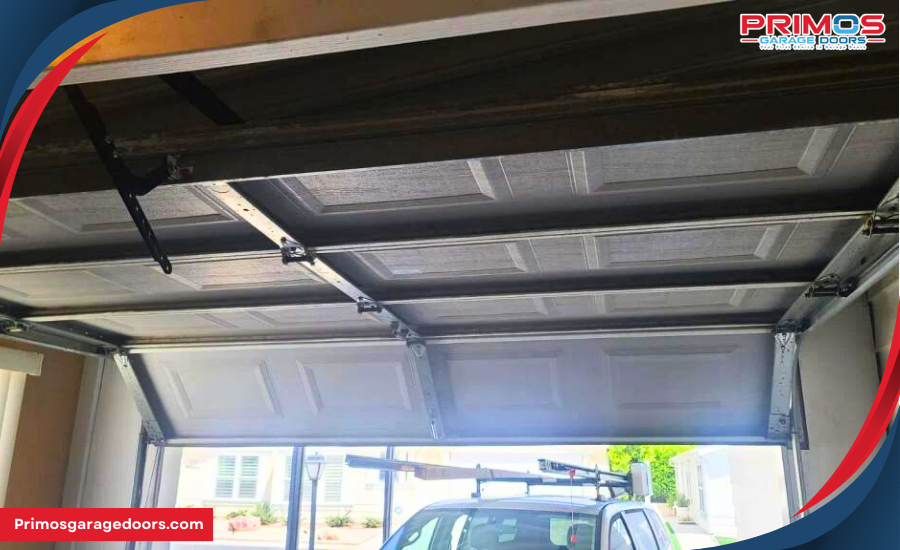
Replacing the Garage Door
When Replacement is Necessary
Knowing when to replace your garage door is crucial for maintaining home safety and functionality. Here are key indicators that a replacement is needed:
- Frequent Breakdowns: If your garage door requires constant repairs, it may be more cost-effective to replace it. Frequent issues with garage door springs, cables, or openers can signal that the door has reached the end of its lifespan.
- Visible Damage: Significant structural damage, such as cracks, rust, or severe dents, can compromise the door’s integrity. A sagging garage door with persistent alignment issues might indicate irreparable damage.
- Noise and Vibration: Excessive noise and vibrations during operation can indicate worn-out components or misalignment. If these issues persist despite repairs, replacement might be the best option.
- Energy Efficiency: Older garage doors often lack proper insulation, leading to increased energy costs. Upgrading to an insulated door can improve energy efficiency and comfort in your home.
- Aesthetic Appeal: An outdated or damaged garage door can detract from your home’s curb appeal. Replacing it with a modern, stylish door can enhance your home’s appearance and value.
Choosing a New Door
Selecting a new garage door involves considering several important factors to ensure it meets your needs:
- Material: Garage doors come in various materials, each with its own benefits:
- Steel: Durable, low-maintenance, and available in many styles.
- Wood: Offers a classic look but requires more maintenance.
- Aluminum: Lightweight and resistant to rust, ideal for humid climates.
- Fiberglass: Durable and can mimic the appearance of wood.
- Insulation: Insulated garage doors help maintain a stable temperature inside the garage, improving energy efficiency and reducing noise. Look for doors with a high R-value for better insulation performance.
- Style and Design: Choose a door style that complements your home’s architecture. Options include traditional, carriage house, and contemporary designs. Consider window options and decorative hardware for added appeal.
- Security Features: Modern garage doors offer enhanced security features such as robust locking mechanisms and advanced openers with rolling code technology. These features can help protect your home from break-ins.
- Budget: Determine your budget before shopping for a new garage door. Prices can vary widely based on material, insulation, and customization options. Balance your needs with your budget to find the best value.
Professional Installation
Hiring professionals for garage door installation offers several advantages:
- Expertise and Experience: Professional installers have the knowledge and experience to handle complex installations. They ensure that all components, including garage door springs, cables, and openers, are installed correctly and safely.
- Safety: Installing a garage door involves handling heavy components and high-tension springs, which can be dangerous. Professionals use specialized tools and follow safety protocols to prevent accidents.
- Warranty and Support: Professional installation often comes with a warranty on both the door and the installation work. This provides peace of mind and ensures that any issues that arise post-installation are covered.
- Efficiency: Professionals can complete the installation quickly and efficiently, minimizing disruption to your daily routine. They also ensure that the door operates smoothly and addresses any potential issues immediately.
Replacing your garage door can enhance your home’s safety, energy efficiency, and curb appeal. By recognizing when a replacement is necessary, choosing the right door, and opting for professional installation, you can ensure a seamless and beneficial upgrade to your home’s exterior. If you have persistent issues with your garage door or are considering an upgrade, consulting a professional can provide the guidance and expertise needed for a successful replacement.
Why Do Garage Doors Buckle?
The Garage Door Material is Too Flimsy
The material quality of a garage door significantly affects its durability and resistance to buckling. Here’s how:
- Thin Metal: Garage doors made from thin metal can easily bend and warp under pressure. Lower gauge steel, which is thicker, is more durable and less likely to buckle compared to higher gauge steel, which is thinner. For instance, a door made from 24-gauge steel is sturdier than one made from 28-gauge steel.
- Poor-Quality Wood: Wooden garage doors can also buckle if the wood used is not properly treated or of low quality. Over time, exposure to moisture can cause wood to warp and lose its structural integrity.
- Fiberglass and Aluminum: While these materials are lightweight and resistant to rust, they can be prone to denting and bending under impact or heavy use.
Choosing high-quality materials, such as thicker steel or treated wood, can prevent your garage door from buckling and extend its lifespan.
The Tracks are Misaligned
Misaligned garage door tracks can cause the door to buckle and lead to significant operational issues. Here’s why:
- Uneven Movement: If the tracks are not properly aligned, the door may move unevenly, putting stress on certain sections. This uneven stress can cause the door panels to bend and buckle.
- Increased Friction: Misalignment increases friction between the door and the tracks, making it harder for the door to move smoothly. The added resistance can warp the door over time.
- Track Wear: Over time, misaligned tracks can wear out faster, exacerbating the problem and increasing the risk of buckling.
Regularly inspecting and adjusting the alignment of your garage door tracks can prevent these issues and ensure smooth operation.
Harsh Weather Conditions
Weather can have a profound impact on the stability and durability of garage doors. Here’s how:
- Extreme Temperatures: Fluctuations in temperature can cause garage door materials to expand and contract. In metal doors, this can lead to warping and eventual buckling. Wooden doors can crack and warp under extreme heat or cold.
- Moisture and Humidity: High humidity and moisture can cause rust in metal doors and rot in wooden doors. This deterioration weakens the door’s structure, making it more susceptible to buckling.
- Wind and Storms: Strong winds and storms can exert pressure on garage doors, especially if they are not reinforced. This pressure can cause doors to bend and buckle, particularly in areas prone to hurricanes or tornadoes.
Using weather-resistant materials and ensuring proper insulation can help protect your garage door from weather-related damage.
The Garage Door Opener is Causing Problems
Issues with the garage door opener can also contribute to buckling. Here’s how:
- Incorrect Force Settings: If the opener’s force settings are too high, it can apply excessive pressure on the garage door, causing it to buckle. This is especially true for older or weaker doors.
- Uneven Lifting: An opener that lifts the door unevenly can put stress on certain parts of the door, leading to buckling. This can happen if the opener is not properly aligned with the door.
- Worn-Out Parts: Components such as chains, belts, or gears within the opener can wear out over time. This wear can cause the door to operate irregularly, increasing the risk of buckling.
Regular maintenance of your garage door opener and ensuring it is properly adjusted can prevent these issues and maintain the structural integrity of your garage door.
Understanding the causes of buckling can help you take preventive measures to protect your garage door. By choosing high-quality materials, maintaining proper track alignment, protecting the door from harsh weather, and ensuring the opener operates correctly, you can significantly reduce the risk of buckling and extend the life of your garage door.
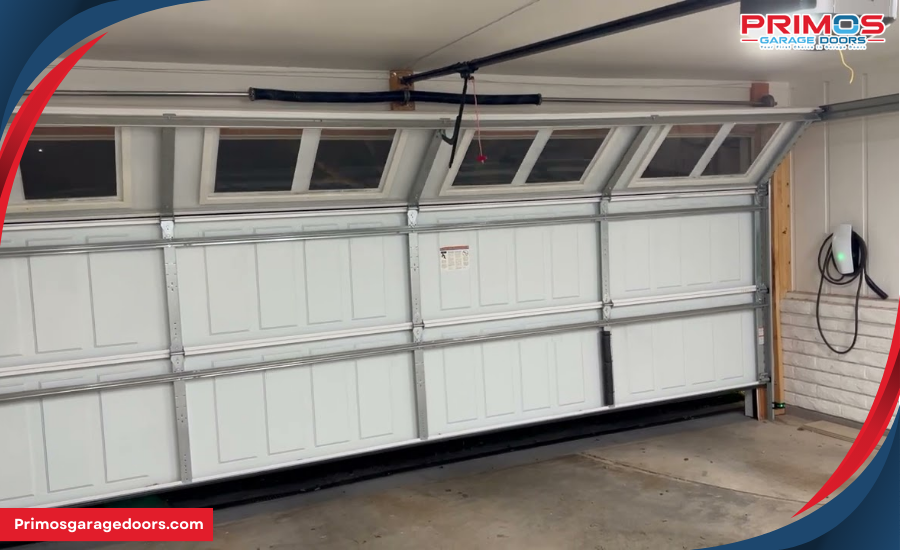
Do-It-Yourself Inspection and Diagnosis
Step-by-Step Inspection Guide
Performing a thorough inspection of your garage door can help identify issues early and ensure it operates smoothly. Here’s a comprehensive guide to diagnosing common problems:
- Visual Inspection:
- Check the Door Balance: Disconnect the garage door opener by pulling the emergency release cord. Manually lift the door to the halfway point. If it stays in place, it’s balanced. If it moves up or down, it’s unbalanced.
- Look for Gaps: When the door is closed, inspect the bottom and sides for gaps. Gaps can indicate misalignment or garage door sagging.
- Inspect the Springs: Examine the garage door springs for signs of wear or damage. Look for gaps between the coils, rust, or breakage.
- Examine the Cables: Check the garage door cables for fraying, wear, or rust. Cables should be taut and free of damage.
- Check Hinges and Rollers: Inspect the hinges and rollers for signs of wear. Ensure that hinges are secure and that rollers move smoothly along the garage door tracks.
- Functional Tests:
- Operate the Door Manually: Lift and lower the door manually to feel for any resistance or rough spots. The door should move smoothly and evenly.
- Test the Balance: With the door halfway open, release it. If it stays in place, it’s balanced. If it moves, adjust the springs or seek professional help.
- Listen for Noises: Operate the door and listen for unusual sounds like grinding, squeaking, or popping. These noises can indicate issues with the garage door opener, tracks, or other components.
- Track Alignment:
- Check Track Alignment: Look at the tracks from inside the garage. They should be straight and parallel. Misaligned tracks can cause the door to move unevenly or get stuck.
- Inspect Track Condition: Ensure the tracks are free of debris and dents. Clean the tracks and use a level to check for alignment.
- Lubrication Check:
- Lubricate Moving Parts: Apply a high-quality silicone-based or lithium-based lubricant to the springs, rollers, and hinges. Avoid using WD-40, as it is not suitable for garage door components.
- Check the Opener:
- Inspect the Opener: Look for signs of wear on the opener mechanism. Ensure the chain or belt is properly tensioned and that the opener operates smoothly without excessive noise.
- Safety Features:
- Test Safety Sensors: Check the garage door opener safety sensors by placing an object in the door’s path. The door should reverse when it detects the object.
- Check Auto-Reverse: Place a small object like a 2×4 board under the door and close it. The door should automatically reverse upon contact with the object.
Tools You’ll Need
Having the right tools is essential for a thorough garage door inspection. Here’s a list of essential tools:
- Wrench Set: For tightening loose bolts and screws.
- Screwdrivers: Both flathead and Phillips for various screws.
- Level: To check the alignment of the garage door tracks.
- Lubricant: A high-quality silicone-based or lithium-based lubricant.
- Step Ladder: For accessing higher parts of the door and tracks.
- Locking Pliers: For securing the door in place during inspection and adjustments.
- Flashlight: To see into dark areas and inspect for wear and damage.
- Tape Measure: To check the alignment and positioning of the door and tracks.
- Safety Gear: Gloves and safety glasses to protect yourself during inspection and repairs.
Performing a DIY inspection and diagnosis of your garage door can help you catch issues early and maintain its smooth operation. Regular checks and maintenance can prevent costly repairs and ensure your garage door remains safe and functional. If you encounter complex problems or are unsure about making adjustments, consider consulting a professional to ensure everything is handled correctly.
Dealing with an Uneven Garage Door the DIY Way
Simple Fixes
Addressing an uneven garage door can often be managed with a few straightforward adjustments. Here are some simple fixes you can try at home:
- Tighten Loose Hardware: Begin by inspecting and tightening all screws, bolts, and brackets. Loose hardware can cause the garage door to misalign and operate unevenly. Use a wrench or screwdriver to ensure everything is secure, especially the brackets holding the garage door tracks.
- Adjust the Tracks: Misaligned tracks can lead to an uneven garage door. Check if the tracks are properly aligned with each other and the door. Use a level to make sure they are straight. If the tracks are not aligned, loosen the mounting brackets and gently tap the tracks back into place with a rubber mallet. Once aligned, retighten the brackets.
- Replace Worn Rollers: Rollers guide the garage door along its tracks and can wear out over time. Inspect the rollers for signs of wear or damage. Replace any worn or broken rollers to ensure smooth and even movement. Opt for nylon rollers for quieter operation and longer life compared to metal ones.
- Check the Springs: The garage door springs play a crucial role in balancing the door. If the springs are not adjusted correctly, one side of the door may lift more easily than the other. Adjust the tension of the springs gradually, testing the balance after each adjustment. If you are not confident adjusting the springs yourself, it’s best to consult a professional.
Safety Considerations
When performing DIY repairs on your garage door, safety should always be a top priority. Here are some key safety tips to keep in mind:
- Use Proper Tools: Ensure you have the right tools for the job, including a wrench set, screwdrivers, a level, and locking pliers. Using the correct tools reduces the risk of injury and damage to the garage door.
- Wear Safety Gear: Always wear safety glasses and gloves to protect yourself from potential hazards. Springs and other components can snap unexpectedly, causing serious injuries.
- Secure the Door: Before making any adjustments, disconnect the garage door opener to prevent accidental activation. Use locking pliers to clamp the garage door tracks and keep the door in place. This will prevent the door from moving while you work on it.
- Handle Springs with Care: Garage door springs are under high tension and can be dangerous to adjust. If you are unsure or uncomfortable adjusting the springs, it’s safer to call a professional. Mishandling springs can lead to serious injuries.
When to Stop and Call a Professional
While many garage door issues can be resolved with DIY fixes, some problems require professional attention. Here are signs that it’s time to call a professional:
- Persistent Imbalance: If your garage door remains uneven despite your efforts, there may be a deeper issue that requires professional diagnosis and repair.
- Complex Spring Adjustments: Adjusting garage door springs can be dangerous and complex. If you’re not confident in your ability to adjust the springs safely, it’s best to hire a professional. Incorrect adjustments can lead to further damage or injury.
- Severe Track Damage: If the garage door tracks are significantly bent or damaged, a professional can replace them properly. Misaligned or damaged tracks can cause the door to become stuck or fall off its tracks, posing a safety hazard.
- Unusual Noises and Movements: Strange sounds like grinding, popping, or excessive squeaking, as well as jerky movements, often indicate more serious issues. A professional can identify and fix the root cause of these problems.
- Door Won’t Stay Open or Closed: If your garage door won’t stay in the open or closed position, it’s a sign of significant imbalance or malfunctioning components. A professional can adjust and repair the necessary parts to restore proper function.
Dealing with an uneven garage door requires attention to detail and adherence to safety measures. While many issues can be fixed with simple adjustments, knowing when to call a professional ensures your garage door remains safe and functional. Regular maintenance and timely repairs can prevent small problems from becoming major issues.
Choosing the Right Professional
Selecting a reliable garage door repair service is crucial for ensuring quality repairs and avoiding further issues. Here are some tips for choosing the right professional:
- Check Credentials: Verify that the company is licensed, insured, and has certified technicians. Proper credentials ensure that the service provider is qualified and accountable.
- Read Reviews: Look for online reviews and testimonials from previous customers. High ratings and positive feedback can indicate reliable and satisfactory service.
- Ask for Recommendations: Get recommendations from friends, family, or neighbors who have had similar repairs done. Personal referrals can lead you to trustworthy professionals.
- Get Multiple Quotes: Contact several companies to get quotes for the repairs. Comparing prices and services can help you find the best value for your money. Be cautious of extremely low quotes, which may indicate subpar service or hidden costs.
- Inquire About Warranties: A reputable garage door repair company should offer warranties on their work. This guarantees that they will stand by their repairs and provides peace of mind in case issues arise after the service.
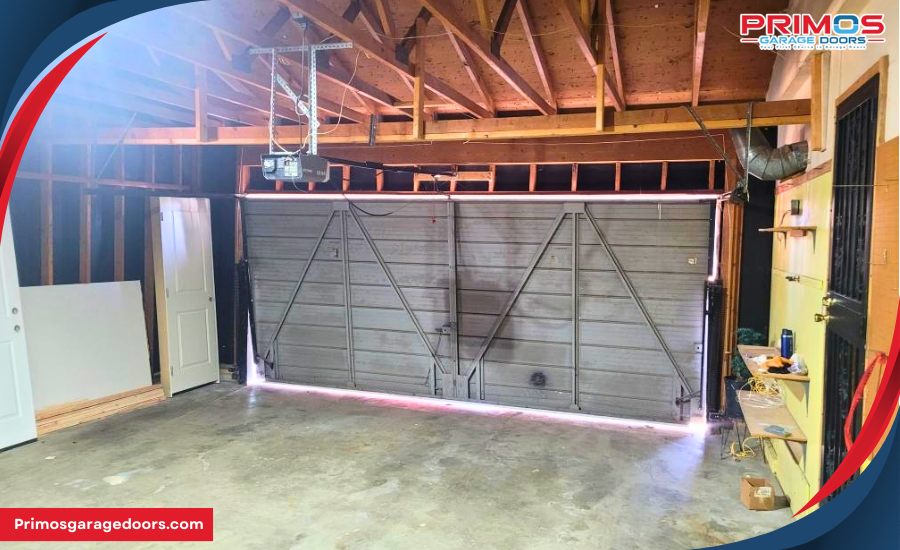
5 Common Causes of Uneven Garage Doors
Wear and Tear
Daily use of your garage door can lead to significant wear and tear, affecting its balance and operation. Here’s how:
- Frequent Operation: Garage doors are used multiple times a day, which puts constant stress on components like springs, cables, and rollers. Over time, these parts can wear out, leading to an uneven garage door.
- Component Fatigue: Garage door springs and cables bear the weight of the door. With repeated use, they lose tension and elasticity, causing the door to move unevenly or sag.
Regularly inspecting and replacing worn components can help maintain the balance of your garage door and ensure smooth operation.
Poor Installation
Improper installation techniques can lead to various issues, including an uneven garage door. Here’s why:
- Misaligned Tracks: If the garage door tracks are not installed correctly, the door may not move smoothly, causing it to become uneven. Tracks need to be perfectly aligned to support the door’s weight and movement.
- Incorrect Spring Tension: Garage door springs must be tensioned correctly during installation. Too much or too little tension can cause the door to lift unevenly, putting extra strain on the opener and other components.
Ensuring professional installation by experienced technicians can prevent these issues and extend the lifespan of your garage door.
Environmental Factors
Weather conditions can significantly impact the balance and functionality of your garage door. Here are some environmental factors to consider:
- Temperature Fluctuations: Extreme temperatures can cause garage door springs and other metal components to expand and contract, leading to imbalance and misalignment. Cold weather can make springs brittle, while heat can cause them to stretch.
- Humidity: High humidity can cause garage door tracks and springs to rust, affecting their performance. Rusty components can lead to an uneven garage door that struggles to open and close smoothly.
Protecting your garage door from extreme weather and regularly lubricating moving parts can mitigate these environmental effects.
Lack of Maintenance
Neglecting regular maintenance is a common cause of uneven garage doors. Here’s how regular upkeep helps:
- Routine Inspections: Regularly checking the condition of garage door springs, cables, and rollers can help identify wear and tear early. Addressing issues promptly prevents imbalance and ensures smooth operation.
- Lubrication: Keeping all moving parts well-lubricated reduces friction and wear, extending the lifespan of your garage door components. Lubrication is essential for maintaining balance and preventing sagging.
A consistent maintenance schedule can prevent small issues from developing into major problems, keeping your garage door in optimal condition.
Material Deficiencies
The quality of materials used in your garage door can also impact its balance and durability. Here’s what to look out for:
- Low-Quality Springs: Inferior garage door springs may not have the same tensile strength and durability as high-quality ones. They are more likely to wear out quickly, leading to an uneven garage door.
- Poor-Grade Metals: Tracks and other metal components made from low-quality materials can bend or rust easily. This affects the door’s alignment and can cause it to become uneven over time.
- Cheap Rollers and Hinges: Using low-quality rollers and hinges can lead to frequent breakdowns and imbalance. Opt for high-grade nylon rollers and heavy-duty hinges for better performance and longevity.
Investing in high-quality materials for your garage door can prevent many of these issues, ensuring it operates smoothly and remains balanced.
Addressing these common causes of uneven garage doors through proper installation, regular maintenance, and using high-quality materials can significantly enhance the performance and lifespan of your garage door. If you encounter persistent issues, consulting a professional can provide the necessary expertise to resolve the problem effectively.
7 Easy Steps to Fix an Uneven or Sagging Garage Door
Step 1: Inspect the Door
Before you begin fixing your uneven garage door, start with a thorough inspection to identify the issues. Look for visible signs of wear and damage. Check for gaps between the door and the frame, misaligned tracks, and any unusual noises when operating the door. Pay special attention to the garage door springs, cables, and rollers to ensure they are in good condition.
Step 2: Tighten Hardware
Loose hardware can cause your garage door to become uneven or sag. Use a wrench or screwdriver to tighten all bolts and screws. Focus on the brackets that hold the garage door tracks to the wall and ceiling, as well as the hinges that connect the door panels. Ensuring all hardware is secure helps maintain proper alignment and smooth operation.
Step 3: Lubricate Moving Parts
Proper lubrication reduces friction and wear on moving parts, helping to prevent garage door sagging. Apply a high-quality silicone-based or lithium-based lubricant to the garage door springs, rollers, and hinges. Avoid using WD-40, as it is not suitable for garage doors. Regular lubrication ensures the door moves smoothly along the tracks.
Step 4: Adjust Spring Tension
Garage door springs play a critical role in balancing the door. If the springs are too loose or too tight, the door may become uneven. To adjust the spring tension, follow these steps:
- Torsion Springs: Use winding bars to carefully adjust the tension. Turn the springs in small increments, testing the door’s balance after each adjustment.
- Extension Springs: Adjust the tension by moving the hook to a different hole in the track hanger. Ensure both springs have equal tension to maintain balance.
If you are not comfortable adjusting the springs yourself, it’s best to hire a professional to avoid injury.
Step 5: Realign Tracks
Misaligned garage door tracks can cause the door to become uneven. To realign the tracks, follow these steps:
- Loosen the screws that hold the tracks to the brackets.
- Gently tap the tracks back into place with a rubber mallet, ensuring they are straight and parallel.
- Use a level to check the alignment and retighten the screws once the tracks are correctly positioned.
Properly aligned tracks help the door move smoothly and evenly.
Step 6: Replace Damaged Parts
Worn-out or damaged parts can contribute to a sagging garage door. Inspect the springs, cables, rollers, and hinges for signs of wear and damage. Replace any broken or worn parts with high-quality replacements. Opt for nylon rollers for quieter operation and heavy-duty hinges for increased durability.
Step 7: Test the Door
After making adjustments and replacing parts, test the garage door to ensure it operates smoothly. Manually lift and lower the door to check for balance and smooth movement. Reconnect the garage door opener and operate the door with the opener to ensure it functions correctly. Listen for any unusual noises and observe the door’s movement to confirm the issues have been resolved.
Following these seven steps can help you fix an uneven or sagging garage door and maintain its proper function. Regular maintenance and timely repairs are essential for keeping your garage door in optimal condition. If you encounter persistent issues or are unsure about any adjustments, consult a professional to ensure the job is done safely and effectively.
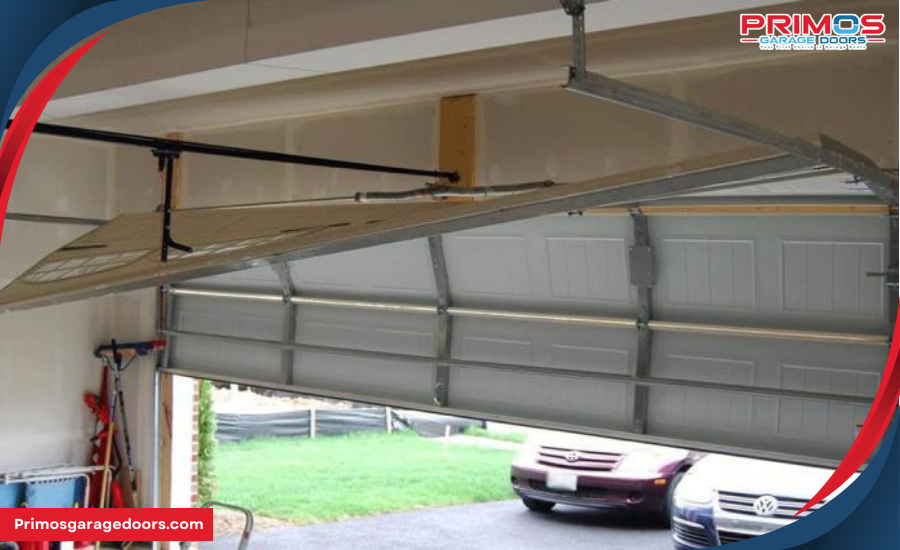
Conclusion
Maintaining your garage door is essential for ensuring safety, security, and smooth operation. Regular inspections, timely repairs, and knowing when to call in professionals can prevent common issues like sagging and buckling. By following the tips and advice provided in this article, you can keep your garage door functioning properly and avoid costly repairs.
If you’re experiencing problems with your garage door, don’t hesitate to reach out to Primos Garage Doors in Lafayette. Their team of experienced technicians is ready to provide the expert service you need to get your garage door back in top shape. Contact them today to schedule an appointment and enjoy the peace of mind that comes with a well-maintained garage door.
Frequently Asked Questions
Why is my garage door bending in the middle?
A garage door bending in the middle often indicates structural weaknesses due to worn-out garage door springs or cables, misaligned tracks, or poor-quality materials. Over time, daily use and exposure to harsh weather conditions can weaken the door’s integrity, causing it to bend. Improper installation and a lack of regular maintenance can exacerbate this issue, leading to more pronounced bending and potential safety hazards. Addressing these problems early through regular inspections and timely repairs can prevent significant damage and ensure the door operates smoothly.
Can I fix a sagging garage door myself?
Yes, you can fix a sagging garage door yourself if the issues are minor, such as tightening loose hardware or lubricating moving parts. Simple tasks like adjusting the alignment of the garage door tracks and replacing worn rollers are also manageable with basic tools and a bit of know-how. However, more complex repairs, such as adjusting or replacing garage door springs and cables, should be left to professionals due to the high tension and potential safety risks involved. Always assess the complexity of the task and your comfort level with DIY repairs before proceeding.
What are the signs of a sagging garage door?
Common signs of a sagging garage door include visible gaps between the door and the frame, uneven closing, and the door appearing crooked when in motion. You might also hear strange noises such as creaking, grinding, or popping, which indicate stress on the door’s components. Additionally, if the door struggles to open or close smoothly, or if it gets stuck midway, these are clear indicators that the door is sagging and requires attention.
How often should I maintain my garage door to prevent sagging?
To prevent your garage door from sagging, it’s recommended to perform maintenance tasks at least twice a year. This includes inspecting and tightening hardware, lubricating garage door springs, rollers, and hinges, and checking the alignment of the garage door tracks. Regular maintenance helps identify and address wear and tear early, ensuring the door operates smoothly and remains balanced. Additionally, scheduling professional inspections annually can help catch more significant issues before they lead to major problems.
What are the risks of ignoring a sagging garage door?
Ignoring a sagging garage door can lead to several risks, including increased safety hazards, further damage to the door and its components, and higher repair costs. A sagging door can fall unexpectedly, posing a danger to people and pets. It also puts extra strain on the garage door opener and related parts, potentially causing them to fail sooner. Over time, the structural integrity of the door can be compromised, necessitating more extensive and expensive repairs or even a complete replacement. Regular maintenance and timely repairs are crucial to avoid these risks.
Contact Primos Garage Doors for Expert Garage Door Services
When it comes to addressing issues like a sagging garage door, Primos Garage Doors offers a comprehensive range of expert services designed to keep your garage door operating smoothly. Specializing in diagnosing and fixing sagging doors, they have the expertise to handle all types of garage door repairs, from replacing worn-out springs and cables to realigning tracks and installing new doors. Their skilled technicians are equipped with the latest tools and techniques to ensure that your garage door is safe, secure, and functional.
Located in Lafayette, Primos Garage Doors is dedicated to providing top-notch service to the local community. Whether you need a quick repair, routine maintenance, or a complete garage door replacement, Primos Garage Doors is ready to help. Their commitment to customer satisfaction and quality workmanship makes them the go-to choice for all your garage door needs. Don’t wait until a minor issue becomes a major problem—contact Primos Garage Doors today to schedule your service and keep your garage door in perfect condition.


